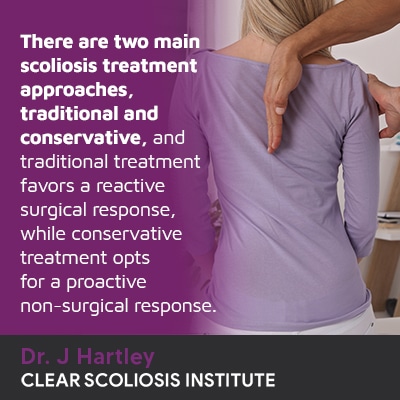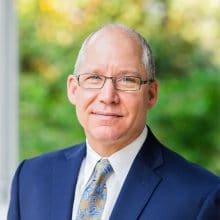![How To Fix Scoliosis Without Surgery [Great Alternatives] Image](https://clear-institute.org/wp-content/uploads/2023/07/fix-scoliosis-without-surgery.jpg)
There is more than one way to treat scoliosis, and different treatment approaches offer patients different types of results. The way in which a scoliotic spine is treated shapes its overall health, strength, and function in the future, which is why the type of treatment chosen can have far-reaching effects.
As a progressive condition, the nature of scoliosis is to get worse over time; however, when a diagnosis is responded to proactively with a customized conservative treatment plan, it can be highly treatable, and many cases of scoliosis don’t require surgery.
Let’s start our discussion of non-surgical scoliosis treatment options by first explaining what it means to be diagnosed with scoliosis.
A diagnosis of scoliosis is reached if an abnormal sideways spinal curve, that also rotates, has developed.
Now, the spine does have a number of natural curves, and these curves increase the spine’s strength, flexibility, and ability to absorb/distribute mechanical stress throughout, but unnatural curves are problematic.
If the spine’s natural and healthy curves are in place, the vertebrae (bones of the spine) are aligned on top of one another as they should be, but if an unnatural curve develops, a number of vertebrae are becoming excessively tilted, and this shifts their position out of alignment with the rest of the spine.
To be diagnosed as a true scoliosis, a scoliotic curve also has to meet a size requirement: a minimum Cobb angle measurement of 10 degrees.
Determined during X-ray, a patient’s Cobb angle indicates how far out of alignment a patient’s spine is, and condition severity is also determined by the Cobb angle:
Not only does a patient’s Cobb angle classify conditions based on severity, it informs the design of customized treatment plans, and for those on the path of traditional scoliosis treatment, it also determines whether or not patients are surgical candidates.

Scoliosis surgery, also known as spinal fusion, has the goal of stopping progression, but this isn’t the same as having the end goal of correcting a scoliosis.
Correcting a scoliosis means achieving corrective results; as a structural spinal condition, treatment has to mainly impact conditions on a structural level, which we’ll return to later.
While there are different types of spinal fusion, most involve fusing the curve’s most-tilted vertebrae, at its apex, into one solid bone, and this is done to eliminate movement (progression) of the fused vertebral bodies.
Permanent rods are commonly attached to the spine to hold it in place, and while, when successful, this approach can hold the spine in a corrective position, it’s not the same as actually correcting a scoliosis through a more natural type of treatment.
The design of the spine is based on movement, so fusing multiple vertebrae together, making the spine more rigid where it’s fused, is contrary to its natural design, and this can disrupt its strength and function.
Some patients experience enough of a loss in spinal flexibility and range of motion to make once-loved activities difficult to participate in and enjoy, impacting quality of life; in addition, a fused spine is more vulnerable to injury, and this knowledge can have a psychological impact on patients.
For those receiving traditional treatment, it doesn’t include a strategy for treating scoliosis while mild, when it’s going to be the most responsive; instead, watching and waiting for signs of continued progression is commonly recommended.
Traditional treatment doesn’t proactively work towards preventing progression, but more so reacts, with surgery, once a certain amount of progression has occurred.
Once a patient progresses into the severe classification of 40+ degrees, they become a surgical candidate.
Fortunately, for those who choose to forgo a surgical recommendation, or are more interested in a less-invasive non-surgical approach, conservative treatment offers just that.
As a CLEAR-certified scoliosis chiropractor, my response to a diagnosis of mild scoliosis, or any severity level for that matter, is not to watch and wait; it’s to start proactive treatment as soon as possible.

The milder a condition is, the smaller the unnatural spinal curve is, the more flexible it’s going to be, and this makes it more responsive to treatment.
As scoliosis progresses, the unhealthy spinal curve is increasing in size, the spine is becoming more rigid, and the condition’s uneven forces are increasing, as are the ways they are affecting the body.
As scoliosis gets worse, it doesn’t just affect the spine, but also its surrounding muscles and nerves.
Once scoliosis becomes compressive in adulthood, nerve compression can cause a number of symptoms felt throughout the body, and as an unnaturally-curved spine pulls its surrounding muscles in different directions, an imbalance can occur as the muscles on one side are overused and muscles on the opposite side are underused.
It’s far simpler to proactively work towards preventing increasing condition severity and effects than it is to attempt to reverse effects that have developed; the main signs of scoliosis in children are related to postural deviation, while the main symptom of scoliosis in adults is pain.
So what exactly does non-surgical scoliosis treatment involve, and what are the benefits?
Conservative treatment is also known as functional and/or chiropractic centered; this is because a conservative approach wants to help patients avoid surgery in the interest of preserving natural spinal strength and function.
By integrating multiple condition-specific treatment disciplines into a treatment plan, it can be fully customized to address the specifics of each patient and their condition.
Through the combination of chiropractic care, a variety of therapies, corrective bracing (when appropriate), and rehabilitation, corrective results can help patients avoid the need for invasive surgical treatment in the future.
While the complex nature of scoliosis is beyond the scope of general chiropractic, scoliosis-specific chiropractic can achieve a number of things: it can work towards adjusting the position of the vertebrae at the curve’s apex and increase spinal flexibility.
The vertebrae at the apex of a scoliotic curve are the most tilted and need to be realigned with the rest of the spine, and this is how the structural condition can be impacted on a structural level.
A number of chiropractic techniques and manual adjustments, performed with advanced mechanical adjusting instruments, can achieve precise corrections that address areas of vertebral subluxation.
In addition, adjustments can be performed on other areas of the body affected by scoliosis, like the hips.
The CLEAR Scoliosis Institute’s treatment approach involves a number of therapies to help prepare the spine, and its surrounding muscles, for treatment, while increasing core strength so the spine receives more support and stabilization from those same muscles.
Massage therapy and/or alternating hot/cold therapy can help with relaxing muscles to make them more responsive to treatment and make patients more able to perform certain therapeutic exercises and stretches.
Condition-specific exercises and stretches, as part of physical therapy, can help a patient warm up for treatment, and can also help increase spinal flexibility, making the spine more responsive to being impacted on a structural level through chiropractic care.
When bracing is deemed beneficial as a facet of treatment, corrective bracing is applied to help augment corrective treatment results.
Corrective bracing can complement other treatment disciplines by gently pushing the spine into a healthier alignment and straighter position, and as bracing is particularly effective on growing spines, it’s most commonly used for treating scoliosis in children.
The final phase of treatment involves further rehabilitating the spine for long-term treatment results.
In most cases, this involves a series of specialized exercises and stretches that can facilitate postural remodeling, improved balance, coordination, and a more natural body position.
These custom-prescribed exercises can target specific muscles that surround the spine, and in many cases, these exercises can be performed at home for sustainability.
As a highly-complex 3-dimensional spinal condition that ranges widely in severity, affects all ages, and has multiple types, it requires a specialized treatment approach.
As a scoliosis chiropractor, I know the spine, how scoliosis affects it, and how best to respond with treatment.
While scoliosis surgery can successfully stop a scoliosis from progressing, the way in which it’s achieved can cost the spine in other ways.
While some patients maintain enough spinal flexibility above and below the fusion site, many find that the fused section’s excessive rigidity is problematic and disruptive to daily life.
As many cases of scoliosis can be treated non-surgically, why not proactively work towards preventing scoliosis from becoming severe, rather than watching and waiting as a curve progresses unimpeded, only to respond with invasive surgery when the surgical threshold is crossed.
A conservative chiropractic-centered treatment approach has been helping patients correct their scoliosis in a way that preserves the spine’s natural strength, health, and function throughout treatment and into the future.
So when it comes to how to fix scoliosis without surgery, we’re talking about responding proactively to a scoliosis diagnosis by starting conservative treatment as soon as possible, when the likelihood of treatment success is at its highest.

CLEAR provides a unique and innovative way of understanding scoliosis. Sign up to receive facts and information you won’t find anywhere else.

I am a very fit 78 year old male, 5'8", 145 lbs. I was very active during most of my life. I was a triathlete for over 30 years including having completed an Ironman race. Because of my scoliosis, my current activity level has been reduce to walking 2 miles a day, riding my bike 150 miles a week, some limited swimming, and golf once a week. I only mention this as the back drop for what I consider a serious and declining scoliosis which keeps me in constant pain, only relieved somewhat by drugs. I have been told that my case is hopeless by physical therapy, chiropractic, and acupunture as well as traditional medicine unless I opt for surgery, which I will not. I currently use a program called "Unlock Your Spine" by Tonya Fines. I live in Kailua Kona, HI 96740. Is there anything you might suggest to help with my scoliosis condition? Travel is very linited because of the scoliosis.
Thank you
Hello, Gerald,
First of all, congratulations on your accomplishments. Those are no small feat. It is important to stay active, although with a curvature in your spine, it can often cause pain depending upon the activity or positioning of your body while doing an activity. Our CLEAR Scoliosis Institute Doctors have worked with patients of all ages with great success in reducing and stabilizing their scoliosis. I would not necessarily agree with the statement that there is no hope; however, standard chiropractic treatment does not have much success in these situations. You would need to see someone who specializes in the treatment of scoliosis. Our CLEAR Doctors have gone through extensive training in this area and have specialized equipment in their offices for scoliosis patients. My recommendation would be to contact the nearest CLEAR Scoliosis Center to you and have your imaging sent to them to determine if you would be a candidate for this type of care. Unfortunately, we don't have any CLEAR doctors in Hawaii. To find the nearest clinic, please visit our website under Find a Doctor. At the very least, I recommend speaking with a CLEAR doctor to see if they know of anyone they'd recommend close to you. Best of luck. Please let us know if we can be of further assistance.